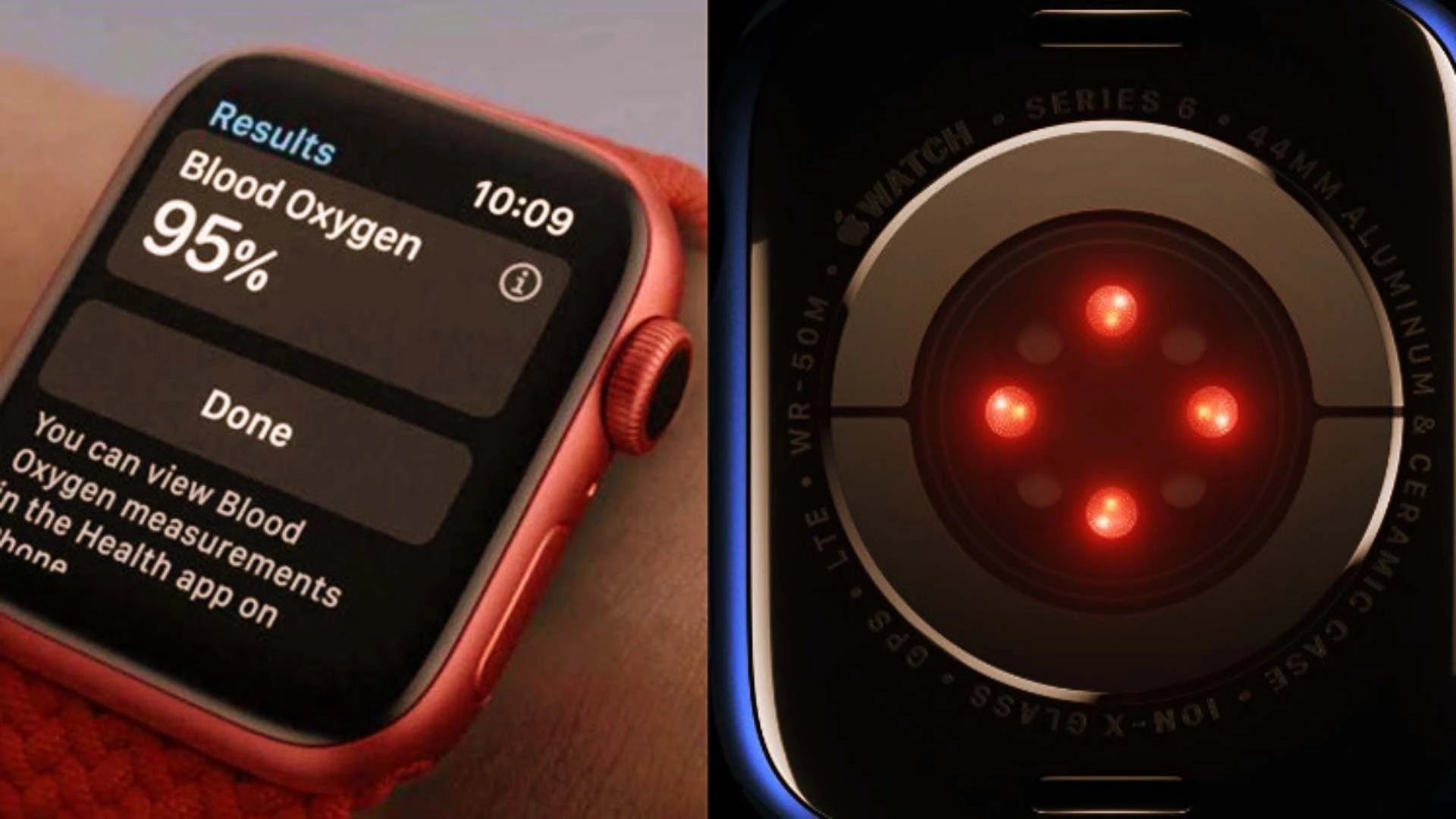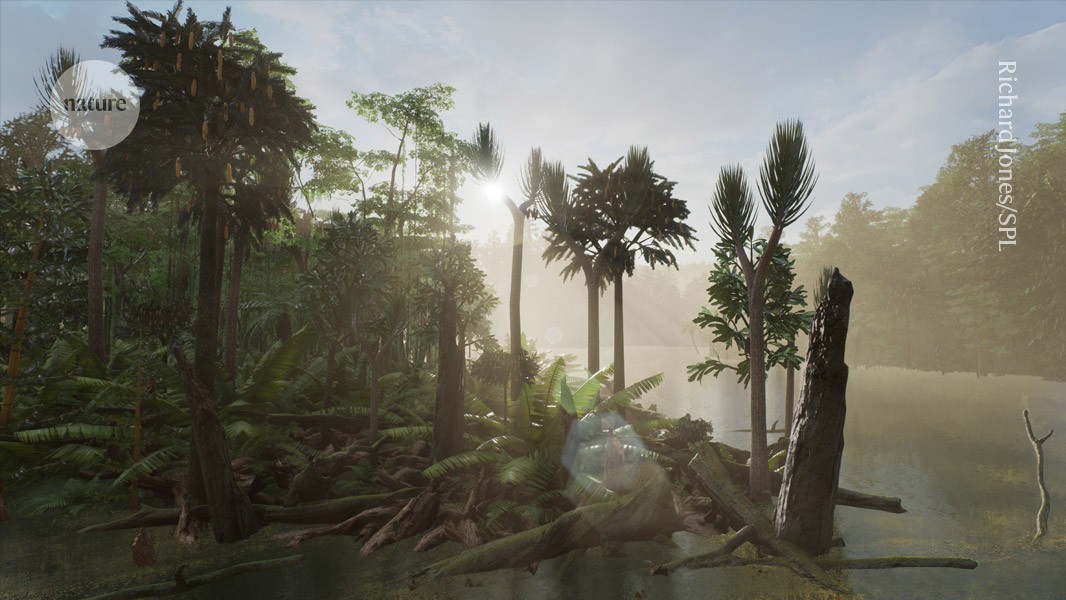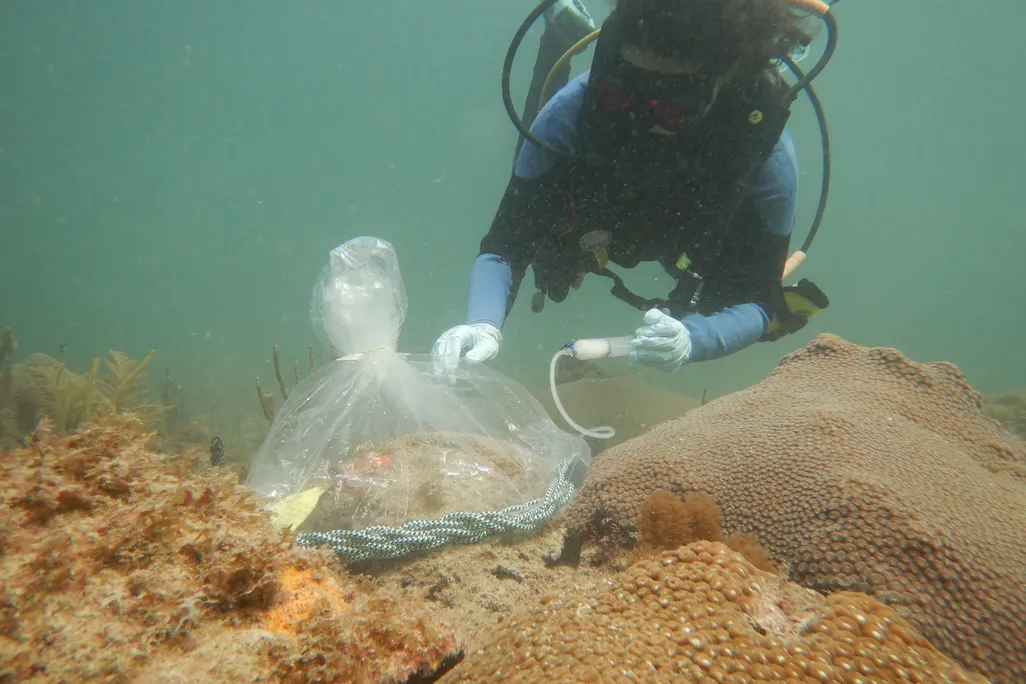A Deadly Disease Is Eating Away at Caribbean Corals and Wreaking Havoc on Reefs. Could Probiotics Be the Solution?
A Deadly Disease Is Eating Away at Caribbean Corals and Wreaking Havoc on Reefs. Could Probiotics Be the Solution?
New research suggests the probiotic McH1-7 could help stop the spread of stony coral tissue loss disease among wild corals near Fort Lauderdale, Florida
Scientists determined the most effective method of halting the disease was covering a coral colony with a weighted plastic bag, then injecting a seawater solution that contains the probiotic. They left the colony covered for two hours to allow the probiotic bacteria to colonize the coral.
Hunter Noren
Probiotics can be good for human health. Now, new research suggests they might also help protect coral reefs.
A bacterial probiotic helped slow the advance of stony coral tissue loss disease—a fast-spreading and deadly condition—among wild corals in Florida, researchers report today in a new study published in the journal Frontiers in Marine Science.
The probiotic may be a good alternative to antibiotics like amoxicillin, which temporarily curb the spread of the disease but must be reapplied frequently. In addition, scientists fear stony coral tissue loss disease may one day become resistant to these antibiotic treatments—just as “superbugs” that infect humans are building resistance to our own drugs.
Antibiotics are meant to kill microorganisms, but probiotics are beneficial living microbes. The idea is that a probiotic can be incorporated into corals’ natural microbiomes, ideally offering them longer-lasting protection.
First discovered in Florida in 2014, stony coral tissue loss disease attacks the soft tissue of more than 30 different species of coral. Without treatment, the disease eventually kills the corals, and their soft tissue falls off, revealing the white calcium carbonate skeleton below. In just weeks or months, it can devastate a whole colony.
Stony coral tissue loss disease can be spread by fish that eat coral, as well as by boaters and divers who do not disinfect their gear. The condition has since expanded its range beyond Florida to reefs throughout the Caribbean.
Several years ago, researchers looking at the great star coral discovered a probiotic called Pseudoalteromonas sp. strain McH1-7. Laboratory tests showed McH1-7 stopped or slowed the progression of stony coral tissue loss disease in infected corals. It also helped prevent the disease from spreading to healthy corals.
But that was in the lab. Would McH1-7 be similarly effective in the ocean? Researchers were eager to find out, so they set up an experiment on a shallow reef off the coast of Fort Lauderdale.
Study co-author Kelly Pitts, a research technician with the Smithsonian Marine Station, applies a paste containing the probiotic directly onto the disease lesion of an infected coral.
Hunter Noren
Experimenting with wild corals
For the study, the scientists focused on 40 great star coral colonies that were showing symptoms of stony coral tissue loss disease. In one experimental condition, the researchers made a paste that contained McH1-7 and applied it directly onto the disease lesions. For comparison, they also applied the same paste, minus the probiotic, to some corals.
In another condition, they covered infected coral colonies with weighted plastic bags, then filled the bags with seawater solutions made with and without McH1-7. They left the corals covered for two hours.
“This created a little mini-aquarium that kept the probiotics around each coral colony,” says study co-author Valerie Paul, head scientist at the Smithsonian Marine Station at Fort Pierce, Florida, in a statement.
The scientists completed all the treatments within the first 4.5 months of the project. Then, they returned periodically to gather tissue and mucus samples from the corals to measure changes to their microbiomes. Over the next 2.5 years, they took photos from a variety of different angles, which they then used to create 3D models that could track the disease’s progression.
In the end, the results suggest covering the corals with plastic bags filled with the probiotic seawater solution was the most effective method. More than two years post-treatment, the colonies that received the probiotic bag had lost just 7 percent of their tissue, while colonies in the control bag condition faced 35 percent tissue loss.
Scientists applied a probiotic paste directly to disease lesions on some corals.
Kelly Pitts
The probiotic paste, by contrast, appears to have made the situation worse: The corals that had the probiotic paste applied directly to their lesions lost more tissue than those treated with the control paste, which did not contain McH1-7.
“We do not really know what is going on with the probiotic paste treatment,” Paul tells Smithsonian magazine in an email.
But she has a few theories. It’s possible the high concentrations of McH1-7 contributed to localized hypoxia, or low-oxygen conditions that further harmed the already stressed corals, she says. Or, the probiotic could have changed the microbiome at the lesion site in some negative way. Another possibility is that McH1-7 produces antibiotics or other substances that were harmful at high concentrations.
Amanda Alker, a marine microbiologist at the University of Rhode Island who was not involved with the study, wonders if this finding suggests McH1-7 is beneficial at specific dosages—a question future laboratory research might be able to answer, she tells Smithsonian magazine in an email. She’s also curious to know which specific molecular components of the probiotic are responsible for the increased tissue loss when applied as a paste.
More broadly, Alker would like to see additional experiments validating the bag treatment method, but she says this “inventive” technique seems promising.
“Their approach is a safer solution than antibiotic treatment methods that have been deployed to combatin the field so far,” she says. “Further, this is a practical solution that could be implemented widely because it doesn’t require highly specialized equipment and has the ability to be used with any type of microbial solution.”
Looking ahead to save reefs
Probiotics are likely not a silver bullet for protecting corals. For one, researchers still don’t know exactly what causes stony coral tissue loss disease, which makes it difficult to determine how or why the probiotic works, Paul says. In addition, since the disease has spread to many different parts of the Caribbean, it might be challenging to use the bag treatment technique on all affected colonies.
“We would need to develop better methods of deploying the probiotic through time release formulations or other ways to scale up treatments,” Paul says. “Right now, having divers swim around underwater with weighted bags is not a very scalable method.”
The researchers have also conducted similar experiments on infected corals located farther south, in the Florida Keys. However, these tests have produced mixed results, probably because of regional differences in stony coral tissue loss disease. This is another hurdle scientists will likely need to overcome if they hope to expand the use of probiotics.
“We probably need to develop different probiotics for different coral species and different regions of the Caribbean,” Paul says.
Researchers returned to gather samples of tissues and mucus to see how the corals' microbiomes had changed.
Hunter Noren
Even so, scientists are heartened by the results of the experiments conducted near Fort Lauderdale. With more research, the findings suggest probiotics could be a promising tool for combatting the disease elsewhere.
“Coral probiotics is a challenging field, because there are hundreds of different types of bacteria that associate with corals, and there are limitless experiments that need to be performed,” Amy Apprill, a marine chemist at Woods Hole Oceanographic Institution who was not involved with the research, tells Smithsonian magazine in an email. “These researchers made a major advance with their study by demonstrating the utility of whole colony treatment as well as the specific probiotic tested.”
Apprill adds that, while antibiotics have been widely used to control stony coral tissue loss disease, scientists haven’t conducted much research to see how these treatments are affecting the plants and creatures that live nearby.
“Using a naturally occurring bacterium for disease treatment may result in lessened impacts to other members of the coral reef ecosystem,” she says.
Amid rising ocean temperatures, scientists expect to find even more diseased coral colonies in the future. Warmer waters may also allow other pathogens to thrive and proliferate. Against that backdrop, Apprill adds, probiotics and the different methods of applying them will be “major allies” in the fight to save coral reefs.
Paul is also optimistic. Through research and field studies, she’s confident researchers will be able to develop interventions that can “help corals better survive changing environments and respond better to diseases and bleaching,” she says.
Get the latest stories in your inbox every weekday.
#deadly #disease #eating #away #caribbeanA Deadly Disease Is Eating Away at Caribbean Corals and Wreaking Havoc on Reefs. Could Probiotics Be the Solution?
A Deadly Disease Is Eating Away at Caribbean Corals and Wreaking Havoc on Reefs. Could Probiotics Be the Solution?
New research suggests the probiotic McH1-7 could help stop the spread of stony coral tissue loss disease among wild corals near Fort Lauderdale, Florida
Scientists determined the most effective method of halting the disease was covering a coral colony with a weighted plastic bag, then injecting a seawater solution that contains the probiotic. They left the colony covered for two hours to allow the probiotic bacteria to colonize the coral.
Hunter Noren
Probiotics can be good for human health. Now, new research suggests they might also help protect coral reefs.
A bacterial probiotic helped slow the advance of stony coral tissue loss disease—a fast-spreading and deadly condition—among wild corals in Florida, researchers report today in a new study published in the journal Frontiers in Marine Science.
The probiotic may be a good alternative to antibiotics like amoxicillin, which temporarily curb the spread of the disease but must be reapplied frequently. In addition, scientists fear stony coral tissue loss disease may one day become resistant to these antibiotic treatments—just as “superbugs” that infect humans are building resistance to our own drugs.
Antibiotics are meant to kill microorganisms, but probiotics are beneficial living microbes. The idea is that a probiotic can be incorporated into corals’ natural microbiomes, ideally offering them longer-lasting protection.
First discovered in Florida in 2014, stony coral tissue loss disease attacks the soft tissue of more than 30 different species of coral. Without treatment, the disease eventually kills the corals, and their soft tissue falls off, revealing the white calcium carbonate skeleton below. In just weeks or months, it can devastate a whole colony.
Stony coral tissue loss disease can be spread by fish that eat coral, as well as by boaters and divers who do not disinfect their gear. The condition has since expanded its range beyond Florida to reefs throughout the Caribbean.
Several years ago, researchers looking at the great star coral discovered a probiotic called Pseudoalteromonas sp. strain McH1-7. Laboratory tests showed McH1-7 stopped or slowed the progression of stony coral tissue loss disease in infected corals. It also helped prevent the disease from spreading to healthy corals.
But that was in the lab. Would McH1-7 be similarly effective in the ocean? Researchers were eager to find out, so they set up an experiment on a shallow reef off the coast of Fort Lauderdale.
Study co-author Kelly Pitts, a research technician with the Smithsonian Marine Station, applies a paste containing the probiotic directly onto the disease lesion of an infected coral.
Hunter Noren
Experimenting with wild corals
For the study, the scientists focused on 40 great star coral colonies that were showing symptoms of stony coral tissue loss disease. In one experimental condition, the researchers made a paste that contained McH1-7 and applied it directly onto the disease lesions. For comparison, they also applied the same paste, minus the probiotic, to some corals.
In another condition, they covered infected coral colonies with weighted plastic bags, then filled the bags with seawater solutions made with and without McH1-7. They left the corals covered for two hours.
“This created a little mini-aquarium that kept the probiotics around each coral colony,” says study co-author Valerie Paul, head scientist at the Smithsonian Marine Station at Fort Pierce, Florida, in a statement.
The scientists completed all the treatments within the first 4.5 months of the project. Then, they returned periodically to gather tissue and mucus samples from the corals to measure changes to their microbiomes. Over the next 2.5 years, they took photos from a variety of different angles, which they then used to create 3D models that could track the disease’s progression.
In the end, the results suggest covering the corals with plastic bags filled with the probiotic seawater solution was the most effective method. More than two years post-treatment, the colonies that received the probiotic bag had lost just 7 percent of their tissue, while colonies in the control bag condition faced 35 percent tissue loss.
Scientists applied a probiotic paste directly to disease lesions on some corals.
Kelly Pitts
The probiotic paste, by contrast, appears to have made the situation worse: The corals that had the probiotic paste applied directly to their lesions lost more tissue than those treated with the control paste, which did not contain McH1-7.
“We do not really know what is going on with the probiotic paste treatment,” Paul tells Smithsonian magazine in an email.
But she has a few theories. It’s possible the high concentrations of McH1-7 contributed to localized hypoxia, or low-oxygen conditions that further harmed the already stressed corals, she says. Or, the probiotic could have changed the microbiome at the lesion site in some negative way. Another possibility is that McH1-7 produces antibiotics or other substances that were harmful at high concentrations.
Amanda Alker, a marine microbiologist at the University of Rhode Island who was not involved with the study, wonders if this finding suggests McH1-7 is beneficial at specific dosages—a question future laboratory research might be able to answer, she tells Smithsonian magazine in an email. She’s also curious to know which specific molecular components of the probiotic are responsible for the increased tissue loss when applied as a paste.
More broadly, Alker would like to see additional experiments validating the bag treatment method, but she says this “inventive” technique seems promising.
“Their approach is a safer solution than antibiotic treatment methods that have been deployed to combatin the field so far,” she says. “Further, this is a practical solution that could be implemented widely because it doesn’t require highly specialized equipment and has the ability to be used with any type of microbial solution.”
Looking ahead to save reefs
Probiotics are likely not a silver bullet for protecting corals. For one, researchers still don’t know exactly what causes stony coral tissue loss disease, which makes it difficult to determine how or why the probiotic works, Paul says. In addition, since the disease has spread to many different parts of the Caribbean, it might be challenging to use the bag treatment technique on all affected colonies.
“We would need to develop better methods of deploying the probiotic through time release formulations or other ways to scale up treatments,” Paul says. “Right now, having divers swim around underwater with weighted bags is not a very scalable method.”
The researchers have also conducted similar experiments on infected corals located farther south, in the Florida Keys. However, these tests have produced mixed results, probably because of regional differences in stony coral tissue loss disease. This is another hurdle scientists will likely need to overcome if they hope to expand the use of probiotics.
“We probably need to develop different probiotics for different coral species and different regions of the Caribbean,” Paul says.
Researchers returned to gather samples of tissues and mucus to see how the corals' microbiomes had changed.
Hunter Noren
Even so, scientists are heartened by the results of the experiments conducted near Fort Lauderdale. With more research, the findings suggest probiotics could be a promising tool for combatting the disease elsewhere.
“Coral probiotics is a challenging field, because there are hundreds of different types of bacteria that associate with corals, and there are limitless experiments that need to be performed,” Amy Apprill, a marine chemist at Woods Hole Oceanographic Institution who was not involved with the research, tells Smithsonian magazine in an email. “These researchers made a major advance with their study by demonstrating the utility of whole colony treatment as well as the specific probiotic tested.”
Apprill adds that, while antibiotics have been widely used to control stony coral tissue loss disease, scientists haven’t conducted much research to see how these treatments are affecting the plants and creatures that live nearby.
“Using a naturally occurring bacterium for disease treatment may result in lessened impacts to other members of the coral reef ecosystem,” she says.
Amid rising ocean temperatures, scientists expect to find even more diseased coral colonies in the future. Warmer waters may also allow other pathogens to thrive and proliferate. Against that backdrop, Apprill adds, probiotics and the different methods of applying them will be “major allies” in the fight to save coral reefs.
Paul is also optimistic. Through research and field studies, she’s confident researchers will be able to develop interventions that can “help corals better survive changing environments and respond better to diseases and bleaching,” she says.
Get the latest stories in your inbox every weekday.
#deadly #disease #eating #away #caribbean















